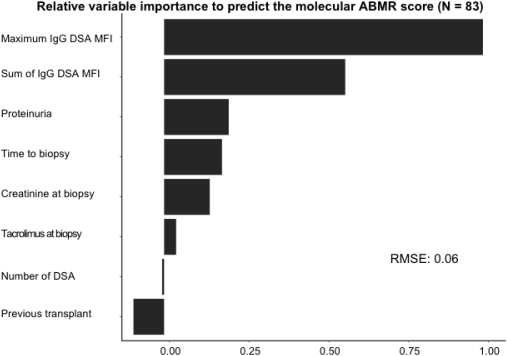The Prediction of Molecular ABMR by Anti-HLA Donor-Specific Antibody Properties.
1Alberta Transplant Applied Genomics Centre, University of Alberta, Edmonton, AB, Canada
2Division of Nephrology and Dialysis, Medical University of Vienna, Vienna, Austria
3Department of Laboratory Medicine and Pathology, Medical University of Vienna, Vienna, Austria
4Department of Clinical Pathology, Medical University of Vienna, Vienna, Austria
5Department of Medicine, Division of Nephrology and Transplant Immunology, University of Alberta, Edmonton, AB, Canada.
Meeting: 2016 American Transplant Congress
Abstract number: D25
Keywords: Gene expression, HLA antibodies, Kidney transplantation
Session Information
Session Name: Poster Session D: Antibody Mediated Rejection: Session #2
Session Type: Poster Session
Date: Tuesday, June 14, 2016
Session Time: 6:00pm-7:00pm
 Presentation Time: 6:00pm-7:00pm
Presentation Time: 6:00pm-7:00pm
Location: Halls C&D
Study purpose: Besides HLA antibody characterization and workup of biopsies (Bx) molecular assessment of gene expression may considerably improve ABMR diagnosis. The objective of the present study, which was performed within an RCT (BORTEJECT Trial, NCT01873157), was to determine late ABMR in a prevalent longterm kidney Tx population, laying focus on the association between serological, morphological and molecular data. Methods: We screened 741 adult kidney allograft recipients for the presence of DSA, identifying 15% DSA+ stable patients. A cross-sectional approach of performing protocol Bx (n=86) after identification of DSA was carried out. Microarrays were performed in 83 Bx and a previously published validated score for the molecular diagnosis of ABMR generated by the Edmonton reference Bx set (N=1212) was applied. Results: Of 83 Bx from DSA+ patients in which microarrays were performed, Banff'13 ABMR was diagnosed in 54%. Using a ≥0.2 cutoff for the molecular ABMR score, an AUC of 0.92 for the diagnosis of Banff'13 ABMR was computed. In a set of variables that might predict the ABMR score  or a combination of molecular and histologic ABMR, IgG MFI revealed the highest importance in a multivariable random forest model. IgG MFI showed a crossvalidated peak accuracy of 0.71 (MFI 1,679) to predict a molecular ABMR score ≥0.2 and 0.70 (MFI 2,395) to combined positive molecular ABMR+histology. Conclusion: The ABMR score is tightly associated with ABMR histology in late DSA+ Bx. Searching for variables able to predict a positive molecular ABMR score, DSA MFI showed a moderate prediction. However, in a set of variables including proteinuria and kidney function, IgG MFI remained most important to diagnose molecular ABMR.
or a combination of molecular and histologic ABMR, IgG MFI revealed the highest importance in a multivariable random forest model. IgG MFI showed a crossvalidated peak accuracy of 0.71 (MFI 1,679) to predict a molecular ABMR score ≥0.2 and 0.70 (MFI 2,395) to combined positive molecular ABMR+histology. Conclusion: The ABMR score is tightly associated with ABMR histology in late DSA+ Bx. Searching for variables able to predict a positive molecular ABMR score, DSA MFI showed a moderate prediction. However, in a set of variables including proteinuria and kidney function, IgG MFI remained most important to diagnose molecular ABMR.
CITATION INFORMATION: Eskandary F, Reeve J, Yoo D, Regele H, Hidalgo L, Böhmig G, Halloran P. The Prediction of Molecular ABMR by Anti-HLA Donor-Specific Antibody Properties. Am J Transplant. 2016;16 (suppl 3).
To cite this abstract in AMA style:
Eskandary F, Reeve J, Yoo D, Regele H, Hidalgo L, Böhmig G, Halloran P. The Prediction of Molecular ABMR by Anti-HLA Donor-Specific Antibody Properties. [abstract]. Am J Transplant. 2016; 16 (suppl 3). https://atcmeetingabstracts.com/abstract/the-prediction-of-molecular-abmr-by-anti-hla-donor-specific-antibody-properties/. Accessed December 30, 2025.« Back to 2016 American Transplant Congress
